 A new study published in the Journal of Affective Disorders looked at how brain–gut photobiomodulation restores cognitive alterations in chronically stressed mice through the regulation of Sirt1 and neuroinflammation.
A new study published in the Journal of Affective Disorders looked at how brain–gut photobiomodulation restores cognitive alterations in chronically stressed mice through the regulation of Sirt1 and neuroinflammation.
“The study deals with how photobiomodulation using multiple modes of emission (Laser diode, IR LED and Red LED) in different tissues at the same time (gut-brain) exerts beneficial effects in a model of depression induced by chronic stress,” study author Albert Giralt Torroella told us. “We hoped to find that photobiomodulation exerted more combined effects on key tissues for depression (such as the gut and brain) rather than targeting the brain alone.”
The research team surmised that combined photobiomodulation might be better than targeting a single tissue given that depression is a complex disorder that involves different systems apart from the central nervous system. Among these other systems, they have the endocrine system, the immune system and, finally, the digestive system, which is one of the targeted tissues of the present study.
There were many reasons as to why the research team chose this topic for their study.
“First, the company that builds the devices was very interested in Alzheimer's disease but we suggested major depressive disorder,” Torroella told us. “Second, in the context of major depression, approximately 30% of patients do not respond to treatment. That means millions of people around the world. In addition, current treatments cause many side effects. And finally, as a psychologist by training, I found this non-invasive and quite patient-tolerable approach very interesting.”
The models of depression induced by stress in mice are very valid and affect the animals in a very variable way, just as it happens in life itself. In collaboration with the company REGEnLIFE, the research team used devices adapted for mice to be able to treat them with photobiomodulation after subjecting them to a protocol of chronic stress. Subsequently, they looked at whether animals treated with photobiomodulation had more or fewer sequelae due to stress compared to animals treated with placebo.
“Because we had many conditions of photobiomodulation, we observed that when it was combined (gut and brain), the improvements in the mice were greater and rather related with their cognitive abilities (memory, etc.),” Torroella told us. “Also, we observed improvements in the grut microbiome composition as well as the reversion of some neuroinflammatory processes due to chronic stres in brain areas.”
The research team was partially surprised with the results because one of the unexpected results was the huge recovery of cogntiive functions such as memory. The second surprising result was the capacity of the non-invasive photobiomodulation to modulate, at least partially, the micorbiome composition.
“We see that photobiomodulation in murine models mainly improves cognitive aspects and neuroinflammatory processes and this is related to resistant forms of depression,” Torroella told us. “Therefore, our vision is that photobiomodulation could be used as a co-adjuvant in the treatment of depressions that are resistant or targeting symptoms that do not improve with current treatments.”
Patricia Tomasi is a mom, maternal mental health advocate, journalist, and speaker. She writes regularly for the Huffington Post Canada, focusing primarily on maternal mental health after suffering from severe postpartum anxiety twice. You can find her Huffington Post biography here. Patricia is also a Patient Expert Advisor for the North American-based, Maternal Mental Health Research Collective and is the founder of the online peer support group - Facebook Postpartum Depression & Anxiety Support Group - with over 1500 members worldwide. Blog: www.patriciatomasiblog.wordpress.com
Email: tomasi.patricia@gmail.com